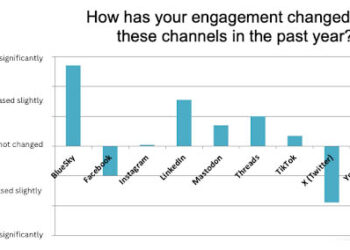Last year, Joe Esposito published an article in the Journal of Electronic Publishing that still resonates with today’s publishing challenges. However, one of his first assertions left me wondering if there wasn’t more to explore:
Attention is the scarce commodity; any service that makes those 24 hours more productive is welcome. A service that winnows through the huge outpouring of information and says (with authority), Pay attention to this; pay less attention to that; and as for that other thing, ignore it entirely—such a service is well worth paying for. The name of that service is publishing.
Is attention a scarce commodity? How is it expended? What factors into it? Is it finite and determined? Or is it malleable? And, if so, are publishers the only ones capable of obtaining it, expanding it, and rewarding it?
I wanted to think this through, and decided to try some simple mathematical statements.
The amount of attention or concentration a consumer is willing to devote to a resource is a function of the time they have available and the perceived relevance of the resource being consumed.
Attention = Time x Relevance
As the relevance of a resource increases so does our willingness to devote attention to that resource, even if our available time remains constant.
Time = Attention/Relevance
The amount of time we spend exploring a topic is a function of the attention we devote and the relevance of the resources we discover.
Relevance = Attention/Time
The more attention we give a subject, the more likely the resource is highly relevant (relevance increases).
When discussing this idea with Kent, he brought up the concept of literacy (fluency). Fluency is our level of expertise within the subject matter being explored. The more fluent we are, the more likely we will quickly identify and digest relevant resources (time will decrease).
The form of information can also determine the time given. A confusing presentation of interesting information can increase the time needed to decode and understand it, while a coherent display of information can shrink the time needed to comprehend it.
And in our digital age, hyperlinks can create an information power function, as users hop from one relevant source to another, either on the same subject or on a related subject.
Defining attention with time is an interesting approach, and potentially problematic. We may choose to devote time to a highly relevant resource (which is good) or we may be forced to devote time because of irrelevant resources. I’m not sure how to reflect the difference.
Discoverability is also a factor that is not directly related to relevance, but does impact time and, therefore, attention.
In looking back at Joe Esposito’s quote, the underlying assumption to a publisher’s value seems to be consumer trust (brand promise). If a consumer trusts the publisher’s assessment of value, then it’s likely they will devote more attention to the products that publisher produces.
A service that winnows through the huge outpouring of information and says (with authority), Pay attention to this; pay less attention to that; and as for that other thing, ignore it entirely—such a service is well worth paying for. The name of that service is publishing.
I’m not sure the name of that service is publishing. If it is, then there are more entities that can be defined as “publishers” than ever before. In some cases even an individual author or moderator is the brand, the source of trust.
So what?
The more publishers (or any entity that is creating, aggregating, or disseminating content) can add focus to resources and assist consumers in discovering those resources, the more likely we are to attract consumer attention and increase their investment of time and, potentially, money in our products.
Discussion
2 Thoughts on "The Pseudo-Mathematics of Attention"
Re. ‘Defining attention with time is an interesting approach, and potentially problematic. We may choose to devote time to a highly relevant resource (which is good) or we may be forced to devote time because of irrelevant resources. I’m not sure how to reflect the difference.’
For me, the utility of any information is always going to contingent upon its relevance, its validity, and the amount of work I have to expend in availing myself of it.
I’ve always admired the principle of ‘information mastery’ ( http://tr.im/o0gH )
‘The ultimate in useful information must have three attributes: it must be relevant to [your] everyday [activity], it must be correct, and it should require little work to obtain. These three factors can be conceptually related in the following manner:
Usefulness = (relevance X validity) / work’
![Reblog this post [with Zemanta]](http://img.zemanta.com/reblog_e.png?x-id=66a67999-c938-4e0a-9f6f-4ba8d80797c8)


